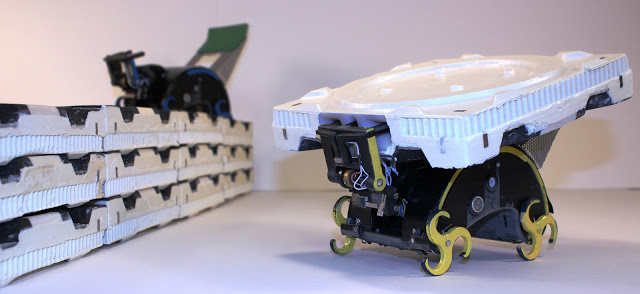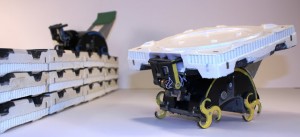February 14, 2014 – If you think Data from Star Trek is the future of robotics, then think again. More and more it appears that the vast majority of our robot companions will not be humanlike at all, but rather come in multiple sizes and shapes with functionality to perform specific tasks.
With the interconnectedness of the Internet, robots will be able to share intelligence and collectively respond to tasks much like a colony of ants or termites. The TERMES Project at Harvard’s School of Engineering and Applied Sciences, in cooperation with that university’s Wyss Institute for Biologically Inspired Engineering, are demonstrating just how swarm intelligence can work.
Results of the project are published in today’s issue of the journal Science. Modeled after termites, the Harvard team created a group of individual robots that work collectively as a construction crew. Their job – to build complex three-dimensional structures without any central authority to guide them, just their combined intelligence. The TERMES robots built towers, pyramids and castles made of foam bricks. When needed they constructed staircases to reach higher levels.
There is no resemblance in the action of these little robots to how humans go up constructing things. We develop hierarchies with architects, project managers, site foreman and workers when doing construction of this type. Not the TERMES robots. They do their work the same way termites and ants go about building a mound. No individual supervises. Instead they use stigmergic collaboration, a collective form of self-organization that uses individual observation and communication leading to appropriate combined responses. Think of how Wikipedia has been assembled and you see a form of stigmergy. Or open source projects like Mozilla Firefox, also benefiting from stigmergic collaboration.
Each TERMES robot executes a job without consideration of other robots around them doing similar work. You can have 5,000 of these little fellows all performing similar actions leading to astounding results. The world of insects demonstrate just how effective collective intelligence based on swarm behaviour can be. Look at the elegance of bee hives, or the complex structures of termite mounds and ant colonies.
How would we harness the power of these little guys? Think about dealing with emergencies like earthquake rescue after a building collapses with thousands of TERMES robots digging out those trapped in the ruins. Or how about sending them by the hundreds of thousands to Mars where they could construct the habitats that arriving astronauts could immediately occupy.
This is a world of difference from Data but nonetheless, TERMES is a powerful demonstration of the future uses of artificial intelligence.






















[…] would come from a new field known as swarm robotics. A number of institutions have been experimenting in this field. Recently a International Journal […]
[…] would come from a new field known as swarm robotics. A number of institutions have been experimenting in this field. Recently a International Journal […]
[…] would come from a new field known as swarm robotics. A number of institutions have been experimenting in this field. Recently a International Journal […]
[…] In the Future Little Robots will Outnumber the Big Ones https://www.21stcentech.com/future-robots-outnumber-big/ […]
[…] In the Future Little Robots will Outnumber the Big Ones https://www.21stcentech.com/future-robots-outnumber-big/ […]